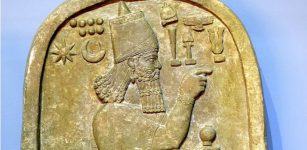Qilin – One Of Four Noble Animals In Chinese Myths And Legends
A. Sutherland - AncientPages.com - In Chinese mythology, Qilin (Kirin) is one of the "Four Benevolent Animals, " including the tortoise, dragon, and phoenix. All four noble ones ruled the Yellow Emperor's gardens - the ancestor of all Chinese people and the father of Chinese civilization.
Qilin is one of four benevolent and sacred animals in Chinese mythology. Credit: tuayai - Adobe Stock
An ancient Chinese myth tells of the god Pangu, who created the heavens and the earth out of chaos. These four divine creatures assisted him. When the work was finished, the Qilin retreated into the dense forest, and since then, he was known as an animal of good omen. One Chinese legend tells of Emperor Fu Xi, who lived two thousand nine hundred years before our era. One day, he saw a magical qilin rising from the Yellow River.
His back was covered with magical markings the Emperor had tried to copy. These signs later became the basis of Chinese writing.
Wonderful Peaceful Creature Walking On The Water Surface
Although his appearance suggests an evil creature, the Qilin is a benevolent, peaceful animal that can walk on the water's surface, soar to the sky, and on the ground without bending down the grass.
He symbolizes the upcoming birth of the sage and the personification of humanity and humanism.
Over the centuries, this divine creature has been known to several cultures and traditions of East Asia. It was described in many different ways because Qilin's appearance represents a mixture of deer, lion, and fish. Still, it can also have a tiger's body, a dragon's head, and an oxtail.
In other descriptions, the Qilin is covered with fish scales or flames and has often been compared to a unicorn having a unique horn in the middle of his forehead.
However, it does not resemble a horned horse, though he is occasionally called a "Chinese unicorn" in the Western world.
Qilin Never Harms The Living Creature
The creature symbolizes prosperity and peace, never harming any plants, animals, or even the most minor bug, but sometimes can get aggressive to punish injustices and the wicked.
Gold gilt wood carving of Qilin on Kitano Temple. Credit: micromagic - Adobe Stock
Legends say the Chinese unicorn is considered the patron saint of all deer, and while the Chinese Phoenix bird is entitled the queen of birds, the divine Qilin is respected as the king among the beasts.
Qilin Mentioned in Confucius' Times
The earliest references to the Qilin are in the 5th century BC ancient Chinese narrative history, Zuo Zhuan (or "Zuo Chronicle"), which describes the events in China 722-468 BC and later, the animal made appearances in a variety of subsequent Chinese works of history and fiction.
The Qilin is believed to have announced the birth of Confucius, c. 552 BC, and the creature's stone depictions continued to appear in the Late Han Dynasty (25-220 AD). In Chinese art, sages and immortals were depicted riding the Qilin to emphasize their uniqueness. When carved on stone tombstones, the Qilin was believed to ward off evil spirits from them and peacefully escort the souls of the dead to heaven. In old China, the Qilin's image was embroidered on the robes of high-ranking imperial courtiers.
Good Omens And Ritual Dance "Kirin-Lion"
Every spring, the ritual dance "Kirin-lion" is performed in one of Tottori's temples. Dancing, the "lion" seeks to soar up and fly away into the sky.
Perhaps even today in China and Japan, the Qilin-kirin is a messenger, handing over to God the people's desire to receive a generous harvest to live in prosperity and security because the Qilin symbolizes good omens, wealth, success, longevity, admiration, and a successful career for high-ranking officers and prominent officials.
Qilin And Five Elements
The Qilin is the incarnation of the five elements, the five symbolic colors, and the five virtues. In Feng Shui, it symbolizes a long life, celebration, splendor, joy, famous descendants, and wisdom.
Using images or figurines of this wondrous animal is recommended for women who want to have a child. Any mascot of the Qilin must face the exit of the living room.
According to the Chinese tradition, the Qilin brings peace and protection to your home and protects against the influence of harmful flying stars.
It must be placed in the living room diagonally from the front door so it always faces the entrance, scaring away enemies and all kinds of problems from your home. While sitting on gold bars and coins, it brings wealth and prosperity.
The presence of the Qilin attracts the powerful cosmic breath of the dragon, thus bringing good luck to all the house's inhabitants. In ancient Chinese mythology, the dragon was a highly significant creature that became a symbol of the Emperor, and his throne was sometimes called the Dragon Throne. Ancient Chinese believed dragons were in control of the weather and water. These creatures were said to be able to manipulate oceans, floods, tornadoes, and storms.
There are nine distinctive Chinese dragons, some serpent-like creatures with large bodies and long heads. In China, the dragon is a benign creature that brings wisdom, power, and luck. They are famous for their goodness, warding off evil, protecting the innocent, and bringing safety to all.
Written by – A. Sutherland - AncientPages.com Senior Staff Writer
Updated on February 15, 2024
Copyright © AncientPages.com All rights reserved. This material may not be published, broadcast, rewritten or redistributed in whole or part without the express written permission of AncientPages.com
More From Ancient Pages
-
 On This Day In History: Terracotta Army Buried With Emperor Qin Shi Huang Discovered – On Mar 29, 1974
News | Mar 29, 2017
On This Day In History: Terracotta Army Buried With Emperor Qin Shi Huang Discovered – On Mar 29, 1974
News | Mar 29, 2017 -
 Morgan Le Fay – Heroine, Goddess, Witch, Fay, Or A Sorceress In Arthurian Traditions
Celtic Mythology | May 28, 2023
Morgan Le Fay – Heroine, Goddess, Witch, Fay, Or A Sorceress In Arthurian Traditions
Celtic Mythology | May 28, 2023 -
 Stele Of Tell al-Rimah And Deeds Of Assyrian King Adad-nirari Against Rebellious Kings
Featured Stories | Feb 22, 2022
Stele Of Tell al-Rimah And Deeds Of Assyrian King Adad-nirari Against Rebellious Kings
Featured Stories | Feb 22, 2022 -
 Neolithic Boats At La Marmotta Reveal People Used Advanced Nautical Technology 7,000 Years Ago
Archaeology | Mar 22, 2024
Neolithic Boats At La Marmotta Reveal People Used Advanced Nautical Technology 7,000 Years Ago
Archaeology | Mar 22, 2024 -
 Askeladden – Little Trickster That Succeeds Where All Others Fail
Featured Stories | Mar 23, 2018
Askeladden – Little Trickster That Succeeds Where All Others Fail
Featured Stories | Mar 23, 2018 -
 Secrets Of The Freemasons – Masonic Symbols Reveal Worship Of Ancient Mother Goddesses
Ancient Symbols | Jun 18, 2018
Secrets Of The Freemasons – Masonic Symbols Reveal Worship Of Ancient Mother Goddesses
Ancient Symbols | Jun 18, 2018 -
 Mysterious Voynich Manuscript Was Written In Two Languages – Scientists Say
Archaeology | Apr 24, 2017
Mysterious Voynich Manuscript Was Written In Two Languages – Scientists Say
Archaeology | Apr 24, 2017 -
 Unique Wooden Stave Churches Were Built Without Nails – Remarkable Technology Helped Them Survive
Featured Stories | Nov 15, 2022
Unique Wooden Stave Churches Were Built Without Nails – Remarkable Technology Helped Them Survive
Featured Stories | Nov 15, 2022 -
 Kingdoms Of Judah And Babylon Remained In Long-Lasting Conflict
Featured Stories | Sep 5, 2019
Kingdoms Of Judah And Babylon Remained In Long-Lasting Conflict
Featured Stories | Sep 5, 2019 -
 Secret Catacombs With Incredible Ancient Skeletons Covered In Priceless Jewelry
Featured Stories | Nov 20, 2018
Secret Catacombs With Incredible Ancient Skeletons Covered In Priceless Jewelry
Featured Stories | Nov 20, 2018 -
 Only Apocalyptic Destruction Can Eliminate The Gap Between Rich And Poor – Historian Says
Featured Stories | Jun 6, 2018
Only Apocalyptic Destruction Can Eliminate The Gap Between Rich And Poor – Historian Says
Featured Stories | Jun 6, 2018 -
 DNA Results Show: Polynesians, Native Americans Made Contact Before European Arrival
Archaeology | Jul 9, 2020
DNA Results Show: Polynesians, Native Americans Made Contact Before European Arrival
Archaeology | Jul 9, 2020 -
 2,000-years-old tomb found in S. China
Archaeology | Apr 6, 2016
2,000-years-old tomb found in S. China
Archaeology | Apr 6, 2016 -
 Silap Inua (Sila): Universal Deity That Controls Life Force Of All Living Things In Inuit Beliefs
Featured Stories | May 22, 2024
Silap Inua (Sila): Universal Deity That Controls Life Force Of All Living Things In Inuit Beliefs
Featured Stories | May 22, 2024 -
 Paris Of Troy: He Caused Destruction Of Troy As The Seer Had Predicted
Featured Stories | Mar 26, 2019
Paris Of Troy: He Caused Destruction Of Troy As The Seer Had Predicted
Featured Stories | Mar 26, 2019 -
 Aethelflaed – ‘Iron Lady Of Mercia’ Was A Brave Female Warrior Who Led Forces Against Danish Vikings
Featured Stories | Aug 2, 2019
Aethelflaed – ‘Iron Lady Of Mercia’ Was A Brave Female Warrior Who Led Forces Against Danish Vikings
Featured Stories | Aug 2, 2019 -
 Why Is Africa Called Africa?
Ancient History Facts | Dec 1, 2020
Why Is Africa Called Africa?
Ancient History Facts | Dec 1, 2020 -
 Beautiful Ancient City Of Pisac In The Sacred Valley, Peru – Incredible Inca Ruins
Featured Stories | Jun 22, 2017
Beautiful Ancient City Of Pisac In The Sacred Valley, Peru – Incredible Inca Ruins
Featured Stories | Jun 22, 2017 -
 Strange Ancient Human Bones And Artifacts Of An Unknown Lost Civilization Found In Nebraska
Featured Stories | Jun 20, 2024
Strange Ancient Human Bones And Artifacts Of An Unknown Lost Civilization Found In Nebraska
Featured Stories | Jun 20, 2024 -
 Mystery Of 3,000-Year-Old Conical Hats – Was It A Highly Advanced Device?
Artifacts | Jun 20, 2020
Mystery Of 3,000-Year-Old Conical Hats – Was It A Highly Advanced Device?
Artifacts | Jun 20, 2020


